#Kurukshetra
Photo

Henri Cartier-Bresson. Refugee camp. India, Punjab, Kurukshetra. 1947
I Am Collective Memories • Follow me, — says Visual Ratatosk
#BW#Black and White#Preto e Branco#Noir et Blanc#黒と白#Schwarzweiß#retro#vintage#Henri Cartier-Bresson#refugee camp#India#Punjab#Kurukshetra#1947#1940s#40s
39 notes
·
View notes
Text

Mahabharat is and will always be my favourite tale to reflect upon and talk to people about. This book was immensely hyped up along with the author. I have now read three of her books. The Last Queen, which admittedly I adored. Then, the Forest Of Enchantments, the book I'd been looking forward to for such a long time. That one left me in a rage.
I went into this book expecting to be pissed off and disappointed. And I wasn't let down on that assumption.
The Palace Of Illusions is a retelling of the great Indian epic-Mahabharata. A tale incorporated so deeply into our hearts that everyone has their own takes and beliefs and opinions about it. I sincerely believe that you cannot write a retelling without angering a number of people. Well, I'm one them.
The writing style:
I didn't have too many issues except i did not get why there were so many rhetorical and philosophical questions? Literal, paragraphs that were nothing but questions.
Draupadi, the enigma, the fire-born, the one person I would fight for as long as there is life in me, why was acting as though she was a little more than a sullen child? In the book that was supposed to be from her point of view, the person, the author did the most injustice with was-Draupadi.
The plot assassination:
As I mentioned above, most of everything in the plot of the epic was butchered and mangled to fit into the author's narrative of women, good-men,bad. It is common knowledge that women's position in society was as downtrodden as depicted here. Don't get me wrong, horrific crimes happened against women and justice was also delivered adequately but the author pulled apart the entire social structure only to be able to say that every bad thing happened to Draupadi was because she is a woman.
~ In the very first chapter, Draupadi said it was egoistic of her father to give her a variation of his own name when her brother, Dhrishtadyumna got an original name. In Vyas Mahabharat, her birth name was Krishnaa but like many people in Hindu beliefs, she was also known as Draupadi, though that is the most commonly used name. So, no points to the author trying to convince everyone that this was sexist.
~ Draupadi was highly educated and trained in many things including economics and she was the one who was in charge of the treasury of Indraprastha. She was a finance minister of sorts. So, saying that King Droupad refused to let her train because she is a woman is stupid.
~Also, I've grown up listening to that Draupadi stepped out of the fire as a young woman. She wasn't a child. Some sources say she was around 16 some say around 25.
~ Are we still stuck about 50 years ago that we're going to be okay with authors portraying that all women in power are evil? Kunti and Draupadi viewed each other as rivals? Draupadi throwing temper tantrums over other women? wtf
~ Draupadi as a pick-me? Half the book Draupadi's internal dialogue is nothing but I don't know how to socialize with other women, they're jealous of each other, they're always giggling, I won't survive the world of women, I can't dance, people don't find me pretty because of my dark complexion(where did white supremacy even came in this conversation) but suddenly out of nowhere Draupadi just knows that every woman is envious of her. She adores the saris and jewellery that she used to find impossible to handle.
~ Maharishi Vyas giving Draupadi Divya drishti to see the battlefield of Kurukshetra came out of nowhere. It felt a forced action done only to show Draupadi's emotions about the deaths.
~ Draupadi harbouring hidden feelings for Karna and him secretly returning those feelings felt like a teenager's fever dream. A teenager who's hellbent on sexualizing everything they come across.
~Bhagvat Gita was witnessed by everyone on kurukshetra including the Virat roop? Again, it felt like a move forced that was done in order to show Draupadi's internal dialogue. How did the author even think she could fit Bhagvat Gita in half a chapter?
~The Pandavas just had no personality whatsoever outside of being obedient to their mother and scared of Draupadi's temper tantrums.
~Krishan ji was told to be this charismatic, carefree, silvertongued diplomat but he was simply shown as someone who randomly showed up and gave unsolicited advice.
~And I don't know what that ending was but you can't be serious telling me that Karna and Draupadi somehow end up together in heaven?
~WHAT WAS THE AUTHOR'S PROBLEM WITH RESEARCHING ABOUT MAHABHARATA???
There was no way the entire plot of Mahabharata could've fit into one book. She tried too but this book sucked. I understand it's a retelling and sometimes had to change but everything here felt so forced. The author broke everything in context to fit into her supposedly feminist ideal. Don't get me wrong, i dislike the Pandavas, the Kauravas and their elders with all my heart but they all had one dimensional personalities. They had caricature-ish depositions. I had no emotions attached to anyone in this book whatsoever. This was a headache.
#the palace of illusions#draupadi#mahabharata#kurukshetra#hinduism#hindublr#desi blog#desi life#desiblr#being desi#desi tumblr#desi tag#desi teen#desi academia#desi dark academia#desi shit posting#arjuna
31 notes
·
View notes
Text
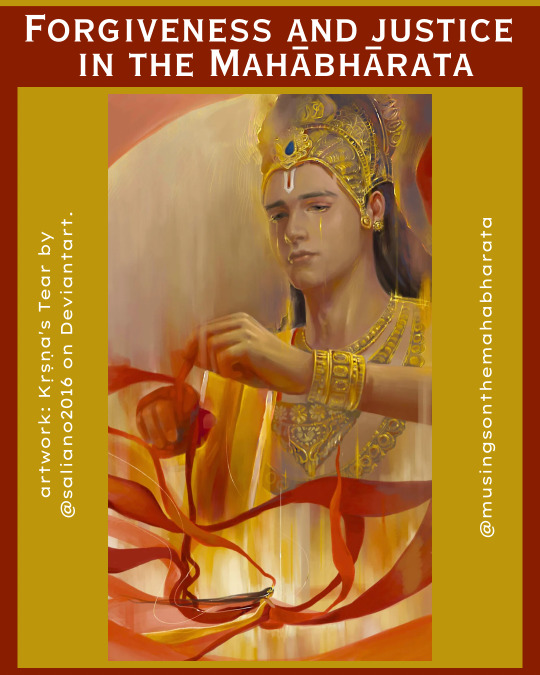

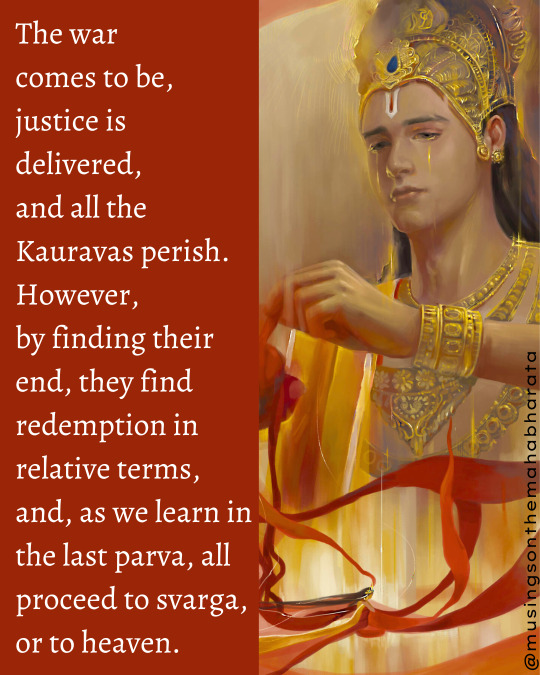
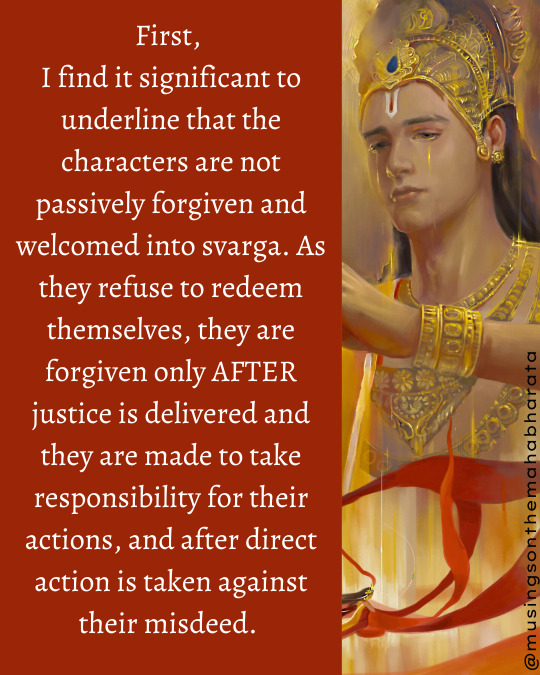
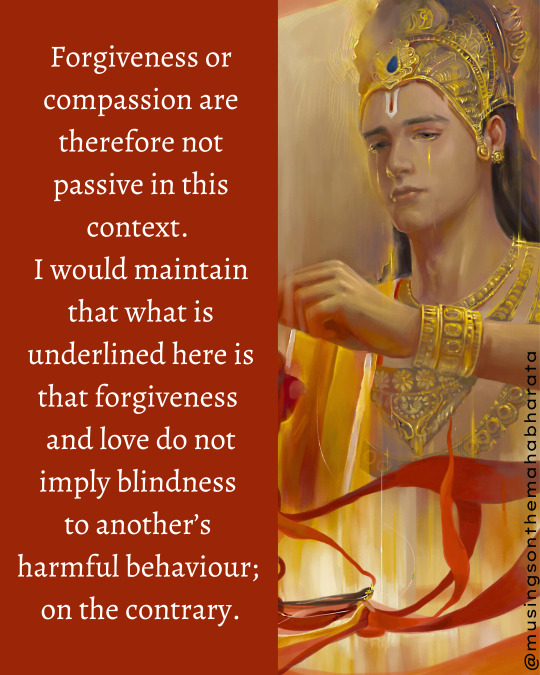
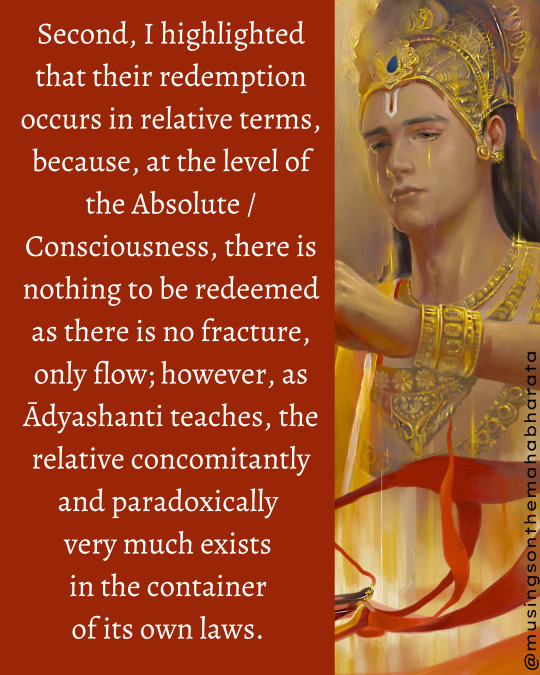
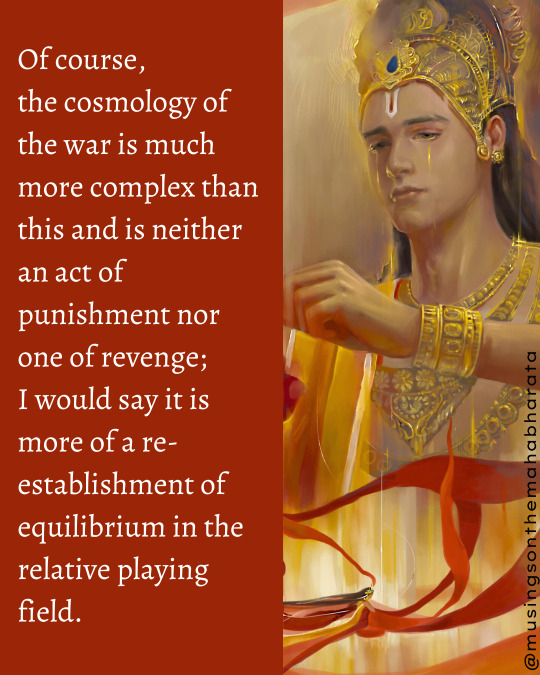
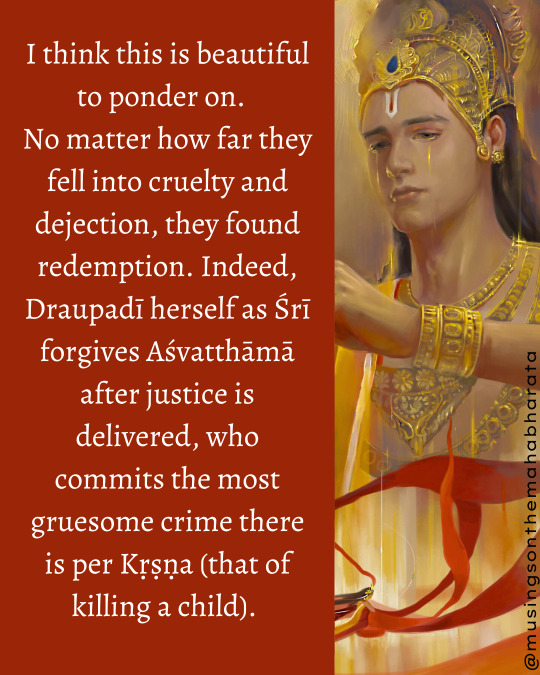
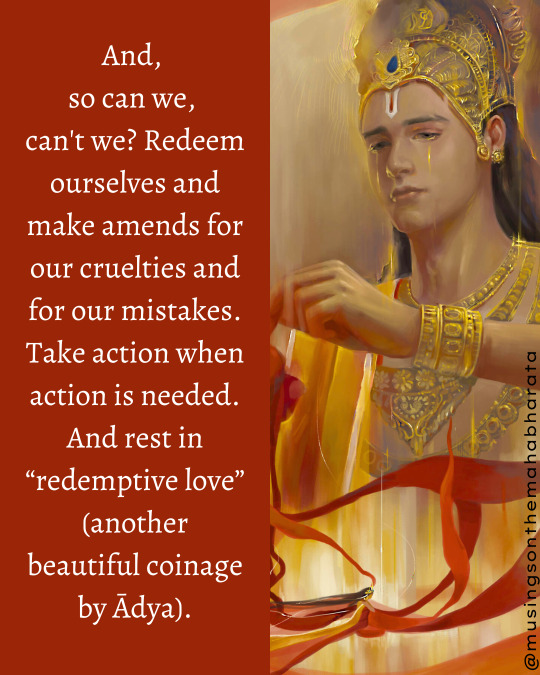
Forgiveness and Justice in the Mahābhārata
The main antagonists of the Mahābhārata, namely, Duryodhana, his uncle, Śakuni, and Karṇa (yes, if antagonists are to be named, Karṇa is one per the Critical Edition and per Kṛṣṇa’s comments) commit a series of horrific actions throughout the epic, motivated by greed, jealousy, and spite. Offences include assassination attempts, deceit, sexual harassment and assault. Still, what I love is that Kṛṣṇa and the Pāṇḍavas continue to offer them opportunities for redemption, which they refuse. The war comes to be, justice is delivered, and all the Kauravas perish. However, by finding their end, they find redemption in relative terms, and, as we learn in the last parva, all proceed to svarga, or to heaven.
First, I find it significant to underline that the characters are not passively forgiven and welcomed into svarga. As they refuse to redeem themselves, they are forgiven only AFTER justice is delivered and they are made to take responsibility for what they have done, and after direct action is taken against their misdeeds. Forgiveness or compassion are therefore not passive in this context. I would maintain that what is underlined here is that forgiveness and love do not imply blindness to another’s harmful behaviour; on the contrary.
Second, I highlighted that their redemption occurs in relative terms, because, at the level of the Absolute / Consciousness, there is nothing to be redeemed as there is no fracture, only flow; however, as Ādyashanti teaches, the relative concomitantly and paradoxically very much exists in the container of its own laws.
Of course, the cosmology of the war is much more complex than this and is neither an act of punishment nor one of revenge; I would say it is more of a re-establishment of equilibrium in the relative playing field.
I think this is beautiful to ponder on. No matter how far they fell into cruelty and dejection, they found redemption. Indeed, Draupadī herself as Śrī forgives Aśvatthāmā after justice is delivered, who commits the most gruesome crime there is per Kṛṣṇa (that of killing a child).
And, so can we, can't we? Redeem ourselves and make amends for our cruelties and for our mistakes. Take action when action is needed. And rest in “redemptive love” (another beautiful coinage by Ādya. I love him so much 😊 )
IG: @musingsonthemahabharata
#mahabharata#itihasa#mahabharatam#hinduism#mahabharat#sanskrit#draupadi#krishna#hindu art#religion#pandavas#dharma#sanatandharma#adharma#kauravas#karna#duryodhana#kurukshetra#dharmakshetra#hindu mythology#adyashanti#bhagavadgita
42 notes
·
View notes
Text
Sri Krishna with Pandavas
#krishna#sri krishna#lord krishna#lord sri krishna#pandavas#kunti#draupadi#bhima#arjuna#yudhishthir#nakula#sahadeva#mahabharata#kurukshetra
3 notes
·
View notes
Text

“We design & produce illustrious experiences. We do this as a collective, with joy and without ego. We remain in motion: challenging convention, innovating technically and mentoring young talent.”
DB Design Tech is one of the Top Graphic designing training centres in Kurukshetra. We are offering Advance courses in Graphic Designing like Video editing, Animation & VFX, 3D Architecture.
GUARUNTEED (100% JOB PLACEMENT ELSE MONEY BACK)
2 notes
·
View notes
Video
youtube
Supane Me Aye Preetam Sainya (2022 Remaster)


Supane Me Aye Preetam Sainya (2022 Remaster)
#youtube#ISKCON#Sitar Music#Bhagavad Gita#Hare Krishna#Krishna#Bhakti#India#kurukshetra#Srila Prabhupada
5 notes
·
View notes
Text
Hot take on Mahabharata:
The Dyutkreera and War were preventable. But they weren't prevented by one of the parties. On paper it may sound like Duryodhana, but it was actually Yudhishthir. He wasn't strong like Bheema or an ace archer like Arjuna.He was a bona-fide politician who used Truth as a weapon. He spoke the truth his entire life except once- the most crucial time when they needed to break Drona's spirit . He bet his wife and let her be humiliated to stroke the fire of his brothers' anger. He made sure that the war was fought to eliminate any and every political rival.
Dharma isn't any uniform "moral " code. It is a code written by the "right" side of the story.
Tagging:@kaurava-apologist @jeyaam
#mahabharat#yudhishthir#duryodhana#kurukshetra#desiblr#hindu mythology#hinduism#vedic culture#hot take
34 notes
·
View notes
Text
नशा,रिश्वतखोरी,भ्रष्टाचार,दहेज प्रथा,जैसी सामाजिक बुराइयों को समाज सुधारक संत रामपाल जी महाराज ने समाज से समूल नष्ट करने का बीड़ा उठाया है और उनके सानिध्य में ऐसा समाज भी तैयार हो रहा है उनके अनुयायियों द्वारा।

4 notes
·
View notes
Text
Tomorrow
Note: This doesn't strictly follow Vyasa's Mahabharat.
The cursed thirteenth night dragged its feet. The sky bore the colour of bile, perhaps in protest of the coming day. The stars hid behind a thick shroud of fog. A biting cold reigned around a group of worn tents, several now abandoned. Krishna pulled his shawl tighter as he untied the horses from the golden chariot. The horses ran towards the river nearby as soon as the ropes came free. Sighing, Krishna began pushing the chariot along the same path. From the shadows, Hanuman, his old friend, appeared, “It’s not your job.” He said, “Didn’t you have those boys who did this?”
“All dead,” Krishna answered. “The chariot needs a wash.” He said as he absentmindedly wiped mud from one of the wheels. Hanuman looked at him, “Let me. You need rest.” Krishna followed Hanuman’s eyes along the long gash running through his left arm. “It’s nothing,” he said.
At the riverside, the water rushed fast but quiet, the blood-red river almost lurking in the darkness. Squatting down in a muddy crevice, Krishna began to scrub the wheel.
Hanuman cleared his throat, “Krishna, do you want to talk? You’ve been pouring more mud than water on that wheel for the past half hour. Besides we’ve been friends long enough.” Answered Hanuman. Krishna smiled, but his eyes were still downcast.
“I’m a cruel person, Hanuman. Hear me out. That boy, that died? His blood is on my hands, and mine alone. I raised him from an infant, handed him a bow and arrow and let him march to his slaughter alone.”
“You couldn’t have known,” said Hanuman.
Krishna laughed cynically, “Except, I knew. I saw the end of his road, from the moment I first looked into his eyes. I saw those warriors butchering him seven to one, and I did nothing. His father was exiled for thirteen years. I raised him! I held his fingers as he learned to walk; my name was the first he learned to speak. I handed him his first bow and told him to shoot. I taught him to hunt lions and recite poems.
“I watched him fall in love, and I was there when he learned to hate. You know, the trap he walked into so willingly? He knew how to break into it, but not how to come out. Every other day he would come to me asking when would I teach him the trick of the Chakravyuha. Every time he asked, I said tomorrow.
“This morning, he came up to me, after he heard the enemy had laid out this formation. He said to me, ‘This one’s on you, Uncle, keep Father safe.’ I smiled at him, and said, ‘I promise.’
“I kept his father safe: far away from him, and that wretched Chakra. He died in there hoping for a miracle, and I made sure it wouldn’t come.
“And yet, here I am. Preparing to drive his father to war tomorrow as if I have nothing to do with his son’s death. I will look his parents in the eyes and promise that I will avenge him!”
Hanuman sighed, “You did what you had to. It took them seven seasoned warriors to take down one sixteen-year-old. At least he gave them hell.”
“What was the use, Hanuman? Am I to still pretend there is any point to this war? You once called me the Lord of the universe. What use is that? I set the wheels of karma to motion myself, but when does it stop? So much power at my fingertips, and yet I’m sitting here mourning an innocent child!”
The night had burst into the first light of dawn. Krishna’s eyes were bloodshot, “My poor Arjuna! He doesn’t even know- the very hands he held as he wept into the night are the ones that are sullied with his child’s blood!”
“You did what you did for the greater good, Krishna.”
“That’s no excuse. I am the one who chooses who lives and who dies, and I chose him to die. All alone, surrounded by monsters. And I decided this a long time ago.”
Krishna tied the horses to the chariot gleaming as the first rays of sun blossomed. “You know what Hanuman,” Krishna turned around. A crazed look had come upon him, “Everybody pays for this. Even me.”
The crack of Krishna’s whip resounded through the valley, as his horses picked up speed, running into the blood-soaked battlefield.
25 notes
·
View notes
Text


👉दिल्ली के बादशाह सिकंदर लोधी के पीर शेख तकी ने कबीर परमेश्वर जी को “52 बार” (52 बदमाशी) मारने का षड्यंत्र रचा जिसे बावन कसनी भी कहते हैं। वह हर बार असफल रहा। क्योंकि कबीर परमेश्वर का शरीर मुरी है अर्थात अविनाशी शरीर है। इस प्रकार अविनाशी का नाश करने में कोई सक्षम नहीं हैं। परमेश्वर कबीर साहेब जी पूर्ण ब्रह्म हैं, सर्व शक्तिमान परमात्मा हैं।
शेखतकी ने जुल्म गुजारे, बावन करी बदमाशी |
खूनी हाथी आगे डालै, बांध जूड अविनाशी ||
2 notes
·
View notes
Photo
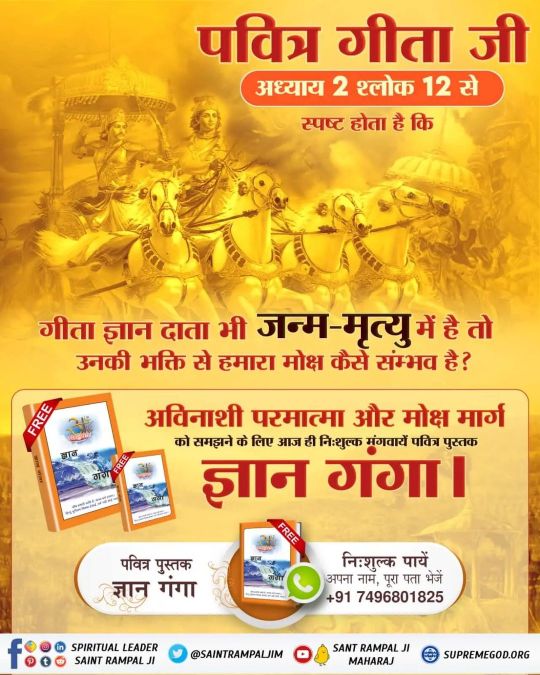
🎯पवित्र गीता जी अध्याय 2 श्लोक 12 से स्पष्ट होता है कि गीता ज्ञान दाता भी जन्म-मृत्यु में है तो उनकी भक्ति से हमारा मोक्ष कैसे सम्भव है? अविनाशी परमात्मा और मोक्ष मार्ग को समझने के लिए आज ही निःशुल्क मंगवायें पवित्र पुस्तक ज्ञान गंगा। #mahabharat #mahabharath #GitaTeraGyanAmrit #bhagavadgita #gita #bhagavatgita #krishnaconsciousness #harekrishna #mahabharatham_tamil #kurukshetra #kurukshetra_city #gitaquotes #SantRampalJiMaharaj #SaintRampalJi #TatvadarshiSant (at Gwalior) https://www.instagram.com/p/CrLyC5ByDMS/?igshid=NGJjMDIxMWI=
#mahabharat#mahabharath#gitateragyanamrit#bhagavadgita#gita#bhagavatgita#krishnaconsciousness#harekrishna#mahabharatham_tamil#kurukshetra#kurukshetra_city#gitaquotes#santrampaljimaharaj#saintrampalji#tatvadarshisant
2 notes
·
View notes
Text
Okay but why doesn’t anyone talk about bheema and Dristadyumna?? Like there are so many things about them in the og Mahabharata where they always keep fighting next to each other, saving each other and saying stuff like “He is more valuable to me than my own soul. I can’t live without him!” There’s like some scenes where Dristadyumna thought Bheema was dead and it’s described like he couldn’t control is tears, was physically shaking and unable to breathe properly.
Plus they keep bugging and dancing together wayy too many times in the war to be platonic.
6 notes
·
View notes
Text
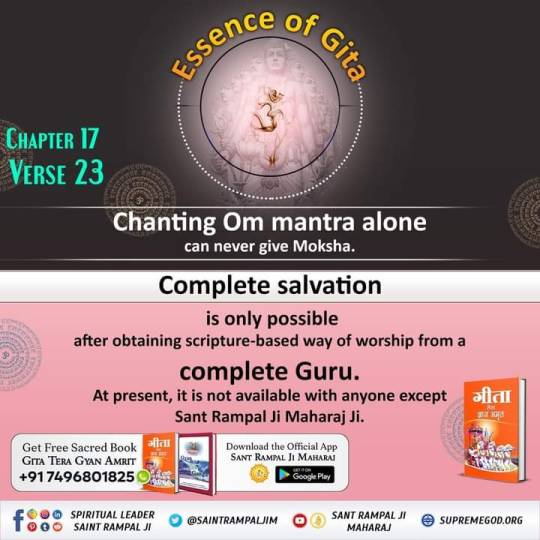
Salvation is only possible after obtaining scripture-based way of worship from a complete Guru. At present, it is not available with anyone except Jagatguru Tatvadarshi Sant Rampal Ji Maharaj Ji.
#bhagavadgitaquotes#bhagavadgita#gitateragyanamrit#gitajayanti#kurukshetra#haryana#krishnaquotes#krishna#lord krishna#shri krishna#mahabharat#kabirisgod#saintrampalji#tatvadarshisaint#god#hindugods
3 notes
·
View notes
Photo
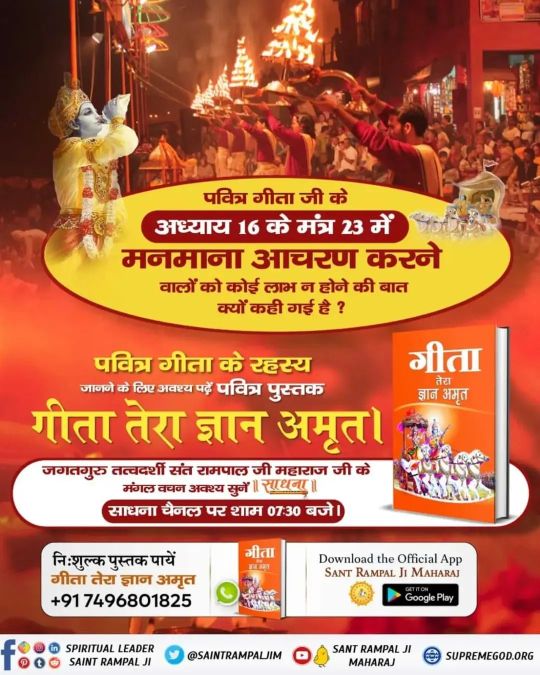
पवित्र गीता जी के अध्याय 16 के मंत्र 23 में मनमाना आचरण करने वालों को कोई लाभ न होने की बात क्यों कही गई है ? पवित्र गीता के रहस्य जानने के लिए अवश्य पढ़ें पवित्र पुस्तक गीता तेरा ज्ञान अमृत। 👇👇👇👇 ➡️Visit Sant Rampal Ji Maharaj Youtube. ✅✅✅✅ . . . . . #bhagavadgita #bhagvadgita #bhagavadgitauotes #bhagwatgeeta #krishnakrishna #haribol #kurukshetra #shrikrishna #krishnaquotes #kanha #SantRampalJiMaharaj #SaintRampalJi #GitaTeraGyanAmrit #om #हिन्दू_धर्म_महान https://www.instagram.com/p/Clgy2R2vLDQ/?igshid=NGJjMDIxMWI=
#bhagavadgita#bhagvadgita#bhagavadgitauotes#bhagwatgeeta#krishnakrishna#haribol#kurukshetra#shrikrishna#krishnaquotes#kanha#santrampaljimaharaj#saintrampalji#gitateragyanamrit#om#हिन्दू_धर्म_महान
5 notes
·
View notes
Text

4 notes
·
View notes
Text
How was Chakravyuha Rachna in (Mahabharata)?
First off, it is difficult to imagine the scale of this formation. The Mahabharat was one of the largest wars ever fought, and armies used a scale of measure known as Akshauhini to measure strength. As single Akshauhini consisted of 21,870 chariots, 21,870 elephants; 65,610 cavalry and 109,350 infantry[1]. Now, it is said that over the course of the war, 18-20 Akshauhini senas (armies) were killed. I do not have to do the calculations for you to figure out how huge the armies actually were. And this in a concentrated around the Kurukshetra, which is roughly 48 x 128 Km in area[2]. That makes a very dense war.
So I imagine that there were enough men to spare for a formation like the Chakravyuha, more so when:
It was designed by Drona, one of the smartest tactician on the side of the Kauravas
The prize was (originally) Yudhisthira, who was the leader of the Pandavas
The formation was designed as a spinning wheel (hence the "chakra" in the name) and a puzzle (hence the "vyuh"), with the formation in a constant state of rotation.... the rotation may be seen as the motion of the helix of a screw. The formation was also called Padmavyuh (or the Lotus formation)[3]. Also, the inner layers were made of of soldiers, each stronger than the ones on the immediate outer layer. Let us use a gaming terminology and call the warriors as levels. Level 7 being the strongest, and lower level warriors at the outside. Here is what would happen to anyone entering through the mouth (now imagine the same thing happening DURING WAR)....

And remember, this doesn't mean the person who entered ran around the maze. The maze engulfed him.. yeah, imagine that:
Think about it... the warrior is in a constant state of battle while the formation circles around him. He keeps getting tired, while the further inside he goes, the less worn out fighters he meets! Both physically and mentally, this makes it difficult for the warrior who has entered.
Now, the Chakravyuh was a brilliant military tactic. Basically it was a juggernaut. The whole formation continuously spun across the battlefield, continuously fighting, and the moment one member of the formation was killed, there was a sliding motion that propagated from the position held by the killed man, right upto the center of the formation, thus ensuring that at all times, there existed a continuous maze.
At last fighting with the opponent soldiers, one reached to the centre of the Chakravyuh that is shown as a ‘point’ in the above figure. This was the time when one was surrounded by the most ferocious of soldiers.
Indeed, it was not easy to reach to the centre and definitely very hard to come out of the ‘Vyuh Rachna’!
It is the evidence of how efficient and tactful our ancient Indian cavalry was!
[1] http://en.wikipedia.org/wiki/Akshauhini
[2] http://www.dharmakshetra.com/holy%20land/kurukshetra.html
[3] http://en.wikipedia.org/wiki/Padmavyuha
5 notes
·
View notes